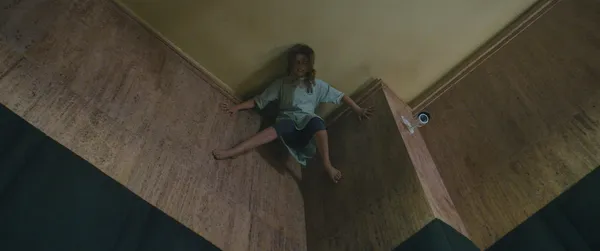 |
| Prey For The Devil Photo: courtesy of Lionsgate |
Most occult horror films featuring exorcism focus on lone priests working unsupported in impoverished neighbourhoods. The experiences they feature are challenging enough, but what about the cases which are referred all the way to the top? Prey For The Devil (aka The Devil's Light), which hits cinemas this week, focuses on an exorcist training college which is the last stop before cases are referred to the Vatican – and practically nobody who goes that far ever recovers. Not only does it raise the stakes in this way, dealing with the big beasts of the demonic world, but it’s unusual in that it focuses on a nun, Annie (Jacqueline Byers), who hopes to follow in the footsteps of Catherine of Siena and become the first woman to conduct an exorcism for over five hundred years.
The film will be doubly interesting to genre fans because it’s directed by Daniel Stamm, who made his name with The Last Exorcism in 2010. Since that and 2014’s 13 Sins, he has spent his time working in television. When we met up to talk about this film, I asked him if he felt that that experience had altered his approach to directing.
 |
| Jacqueline Byers and Posy Taylor in Prey For The Devil Photo: Vlad Cioplea |
It didn’t really change it, he says, but it did give him more confidence.
“In TV, there's just no time. You get the script when you get on the plane on your on your way there, you have one week of pre production, and then you are on set. There's only time to prepare the broad brush strokes. So in the beginning, it's terrifying because you stand on set so aware that you're not prepared, and you're being shown a cast that you didn't cast yourself and that knows the characters much better than you do. And you just have to get your creative ego out of the way and say ‘I'm just a guest in this world.’
“I know I have to learn the language as fast as I possibly can and just not get in the way and let the machine do its thing. Whereas in movies, of course, you are creating that world. You are casting every single character. Every decision there is is yours. So you just know every single aspect of that world, which gives you more confidence because you sit with a script for, in most cases, a year. I know every line exactly. The combination is actually great. I still prepare for a feature film, as in depth as I always have, but then when I get on set, no matter how much I prepared, I always have the feeling I haven't prepared enough. I could prepare for two and a half years. So now with the TV experience, it's much less threatening. It's maybe the main difference.”
So how long did he have to work with this one before it went to shooting?
“That's an interesting question,” he says. “I was the second director on it. So there was another director – a UK director, actually – who quit a week before pre-production. So I suddenly got a call, and they said ‘Can you be in Romania on Friday?’ This was Tuesday. And I said ‘Okay, sure.’ And that would have been very much the case, that I just got the script and it was almost like a TV project where there is no time to change anything, you just fly over and shoot it as it is on the page. And then everything changed.
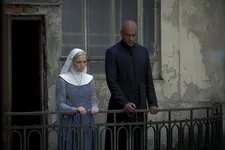 |
| Jacqueline Byers and Colin Salmon in Prey For The Devil Photo: Vlad Cioplea |
“It changed two days later, when suddenly it was ‘Forget Romania, we're now shooting in Bulgaria.’ But it was the same thing. I got on the plane with a script prepared to go into pre-production just the way it was, which is not my favourite way, but if necessary, you know, we'll do it. And then we started pre-production, and then Covid hit, and everything got shut down, and everybody got sent home.
“So suddenly, we were forced into a six month hiatus. And of course, you're sitting at home by yourself. We had six months to work on the script and develop the script and try different things. So we had constant Zoom meetings, and we were writing, writing, writing; developing, developing, developing. So by the time we got back to Bulgaria to finish pre-production and to shoot, it was very much a feature project where I was behind every single sentence that was in that script. And it felt like a very different project all of a sudden, in a great way.”
The same team remained on board, he says.
“The main actress, Jacqui Byers, is someone I’m such a fan of because she can do absolutely everything. She actually was handed down to me from the previous director. The studio sent me a video of Jacqui, the casting video, and said ‘Here's an actress. We'd love it if you love her.’ And of course, as a director, you want to cast your own leads. That is the main tool in your toolbox. So I was very sceptical, and I was like, ‘I don't think I like this, but let me just watch this tape...’
“She was stunning. She was amazing. Within a two minute uninterrupted take, she showed you the whole palette of what that character needs to be – the vulnerability and the rage and the kick-assness. And we never saw, we never did auditions for anyone else. It was always Jacqui in my world. Everybody else was cast after that, when we were in pre production, so that from then on it was a very normal find your cast process.”
 |
| Jacqueline Byers and Virginia Madsen in Prey For The Devil Photo: Vlad Cioplea |
I was pleased to see Virginia Madison there, I tell him, because to my mind, she’s one of the best actresses of her generation working at the moment. Was she interesting to work with?
“Great, great,” says Daniel, nodding appreciatively. “I mean, at first we jumped on Zoom. At the time, because I'm such a fan, I was like, ‘Dude, I get to talk to Virginia, I hope I'm not going to come across stupid or something.’ And she challenges you. She very much does. She says, like, ‘Make this character interesting to me.’ And she said ‘I want to be clearly defined. Am I going to be a supporter or an antagonist and obstacle for her? Don't let me be wishy washy also in the room. I need to be able to influence the story in a meaningful way.’
“It's great to be challenged. Terrifying in the moment.” He laughs. “But for the character, of course, it's great to be challenged that way. And then once we delivered that, she was nothing but supportive and great, and could not be a sweeter person. You know, she is incredible. And it gives the entire cast something. You know, there is this celebrity on set, and for her to be this laid back and personable and relatable, it just makes everybody relaxed and it makes all the difference. So she was great. Colin Salmon, same thing. So great. So gracious, so supportive, such a role model. They’re just amazing people to work with.
“I've always found that the difficult actors are the actors that are scared that you will ask something of them that they are not able to deliver, that is outside of their range. And the really talented actors, no matter how much of a celebrity they are, they are oftentimes not that difficult, because they know that their talent is endless. They can give you what you ask for. You know, Jacqui Byers, you could ask her to play the role with two noses and five ears and somehow, magically, she would be able to deliver that. And because she has the confidence that she knows her talent is bottomless, she has never been difficult for a split second, because anything you throw at her is a challenge for her and she's embracing it.”
 |
| Posy Taylor in Prey For The Devil Photo: Vlad Cioplea |
Going back to what he said about her playing a kick-ass character, I suggest that this part of what makes the film interesting, because we’re used to seeing very particular, quite limited representations of nuns.
“Our screenwriter, Robert Zappia, is a practising Catholic, which made everything so different because every project I've been involved with so far, like The Last Exorcism, there wasn't a single believer involved with the making of the movie, not a single person who believed in God or the devil or demons or whatever. So for this one to have its roots in Catholicism, you know, by a non cynic, made all the difference. His first draft that I read was so full of research, because he had talked to a real life exorcist whom he knew through a friend who was a deacon. This exorcist told him all these stories that are fascinating.
“There are two lectures in the movie, I think there were like something like eight lectures in the original script. And in the final movie, every word we are saying about the academies and about possession, all these things, everything that the church does, is all true. You don't have to make up anything, because it's all there. And it's all terrifying, you know? So I didn't do any research beyond that, at all, because it was all in there and there was so rich, and the task was almost the opposite: how do we pin out the facts so that it doesn't get in the way and there's time for a cinematic forward momentum, while still conveying that world?
“With the nun, why I love that character so much is that usually nuns, just like the Church, get conveyed in a very one dimensional way, you know? That's their calling, and that's why they are there, and now they are a nun. They know they're there to serve, but there isn't much personality, whereas this character, she wasn't a nun first. She was dealing with her mother's possession, and had the demon in her life the entire her entire life, and her becoming a nun is just a step in her battle. She was like, ‘Where can I get the tools, the weapons, to fight this demon?’ So she became a nun. Because of that, because she wasn't a nun first, her being a nun was just an expression of her knighthood, almost, in this battle. She was so full of character and so interesting that I just loved the script from the beginning.”
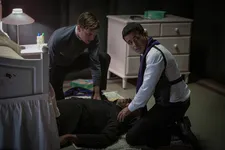 |
| Christian Navarro in Prey For The Devil Photo: Vlad Cioplea |
Presumably one of the reasons why he was sought out for this film was The Last Exorcism, so how did he go about making this exorcism visually different and distinctive?
“It was very simple,” he says, “because the movies are so different. The basic question in The Last Exorcism is ‘Is this girl crazy or is she possessed?’ and it takes 90 minutes until we solve that mystery. That also meant that when we made it, we could never do supernatural stuff that would give away that she is possessed. We couldn't have her levitate, we couldn't do contortions that were too crazy, all that stuff. Prey For The Devil is the opposite. It's basically saying these first 45 minutes in a normal exorcism movie that are full of the doubt of ‘Is this really possession or is this something else?’ – let's just cut that out and say ‘You bought a ticket for an exorcism movie, guess what? It's a real possession.’ We don't need 45 minutes of doubt and going back and forth, back and forth. And suddenly that opens up an additional 45 minutes that you can use for much more elaborate possession sequences, and you don't have to sacrifice any story or any character for it. You can have it all.
“So Prey For The Devil has, I would say, twice as many exorcism sequences as another movie would have. We get to do what a usual exorcism movie only gets to do in the third act to pay everything off. It's just one climax and then you're out. We get to do that throughout the movie. And then the challenge was just how do we give our world the mythology so that it remains fresh and suspenseful, and people who have already seen 20 exorcism movies get something new, while we also lean into to the set pieces for people where it's their first exorcism movie?
“After The Last Exorcism, there was a 13 year old who did a review on YouTube that I'll never forget. It was his first horror movie ever in his life, and he reacted to things that I thought were the least interesting things in the movie because they were the clichés. That to him was the most mind blowing stuff because he wasn't jaded by all these other movies that he had seen before. And since then I have remembered, I have to keep that boy in mind. I'm making a movie for that audience too. I'm not just making a movie to impress my fellow horror filmmakers and go like, ‘See what I did with this exorcism? It's really new and original.’ I also have to fully deliver the set pieces in a non cynical way, I need to fully lean into it and find a way to make it fresh within that.”
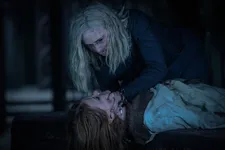 |
| Down in the catacombs in Prey For The Devil Photo: Vlad Cioplea |
We talk about the location, which contributes strongly to a combination of Medieval and modern aesthetics. and he tells me that before finding it, he had pictured the story in a very different way.
“When I read the script it was very Vaticany. Marble. White, cold stone. The echoes that come with that. The high ceilings, all that stuff. And then I'm talking to the Bulgarian location department and they're saying ‘You realise that we are an Orthodox country, we don't have that Catholic architecture you are talking about?’ And it's like, ‘Oh, we didn't know. We’re in trouble now.’ And then we started location scouting in Bulgaria and we came across the university in the capital, Sofia. And it had been shut down because it was Covid, but we went back into production during Covid.
“Because it was a socialist country, nothing was renovated. You have this beautiful old building, but everything was so run down that no matter where you pointed the camera, you just felt that this was a real, lived-in world. If you had wanted to create that in production design, this would have been a $100 million movie because that budget would have exploded. But the way it was, we could just use that university.
“Of course, all the other stuff that you're talking about with the modern technology stuff, our production designer [Jonathan McKinstry] put in. It obviously wasn't there. But we have the greatest production designer ever. He had started as a carpenter on Indiana Jones, on Raiders Of The Lost Ark. He couldn't believe what all you can afford in Bulgaria that you could never afford in the UK. He's from the UK. And so that allowed us to really pump all our budget into the third act where we had to build the catacombs. The catacombs are completely built from Styrofoam on a soundstage. Every statue that you'll see, it's all made from Styrofoam and painted. It's an incredible achievement of craftsmanship. You could walk through there and as long as you didn't touch anything, you just really were in that space.
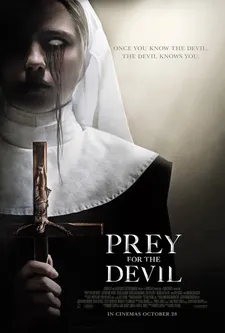 |
| Prey For The Devil poster |
“The shoot was unlike anything else because of Covid. There were all these things we had to do, the whole team. Literally 100 people had to go wash their hands once an hour. So you lose 20 minutes out of your hour just to the hand washing because you're like, ‘Okay, where's the camera operator? Oh, he's still washing his hands.’ Then we couldn't have lunch together. The team was split into people with a green scarf tied around the wrist and people with an orange scarf, and the green scarves weren't allowed to talk to the orange scarves. And the people that handled the actors had a different colour and it was like, you know, communication on a film set is absolutely everything, and suddenly you have masks up to here so you only ever see people's eyes and and you're only allowed to talk to the people you need to talk to.
“Then we had to test three times a week with the old tests that were this long” – he holds up his hands – “that go right up into the brain and then turn around. I mean, it was tough to focus on the actual story you're telling. It took everything out of us, but we had the greatest cast, which is always everything. if you have a great cast, you can do anything. If you have a difficult cast, it's amazing how the easiest things suddenly become impossible to do. So we were really lucky with our with our cast.
“The most enjoyable part to me was there are all these still frames of possession when she [Annie] does the research. So I got to shoot all those with my iPhone. We took a whole day of just staging those and then shooting those, and that was the most fun because it was the least time pressure, it required the smallest team, and it was very different from what I usually do. It was like a photo shoot. So ironically, that was the most enjoyable day altogether. But other than that, any minute I got to spend with Posy Taylor, our ten-year-old actress, was incredible.”
Prey For The Devil is in cinemas from Friday 28 October.





















